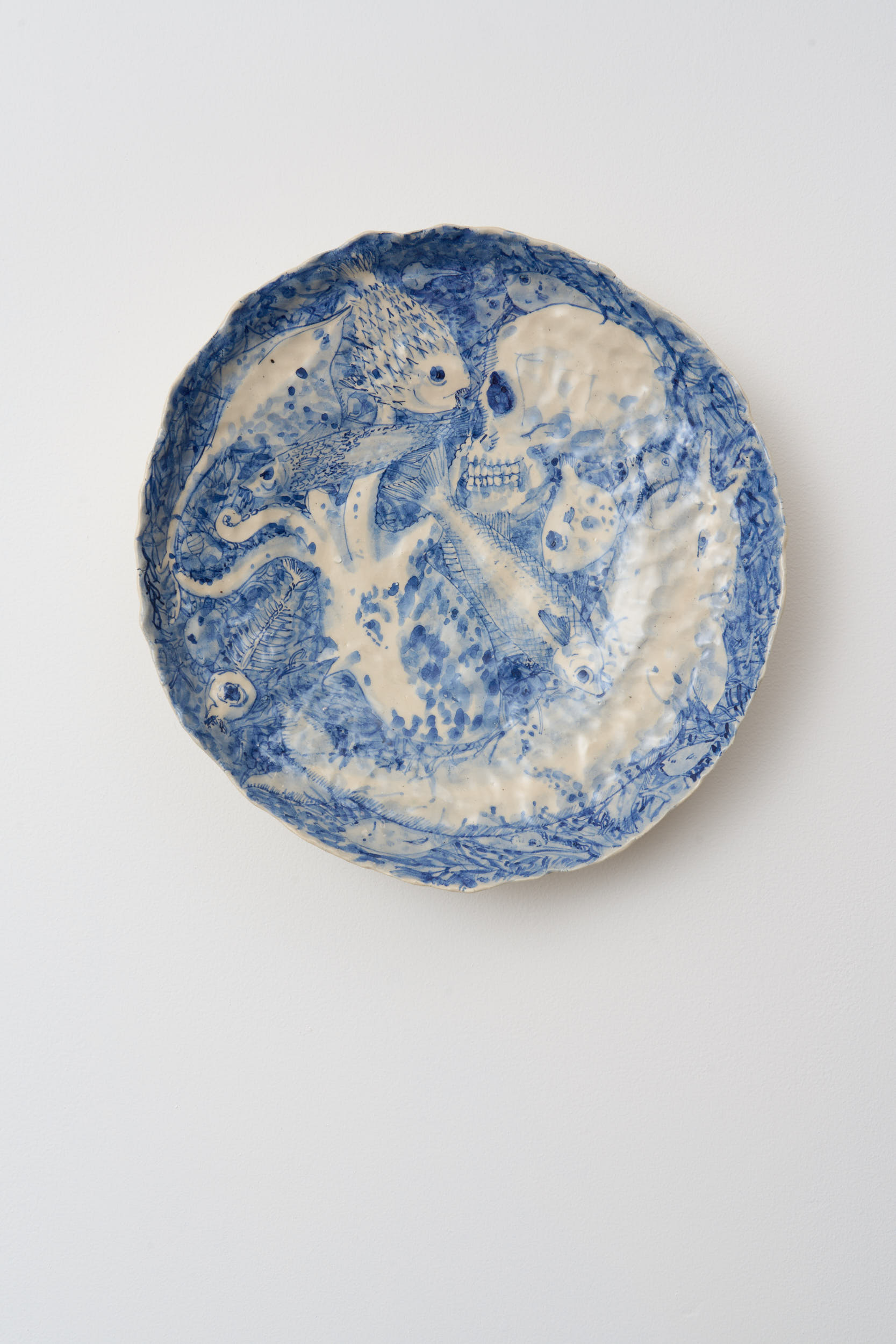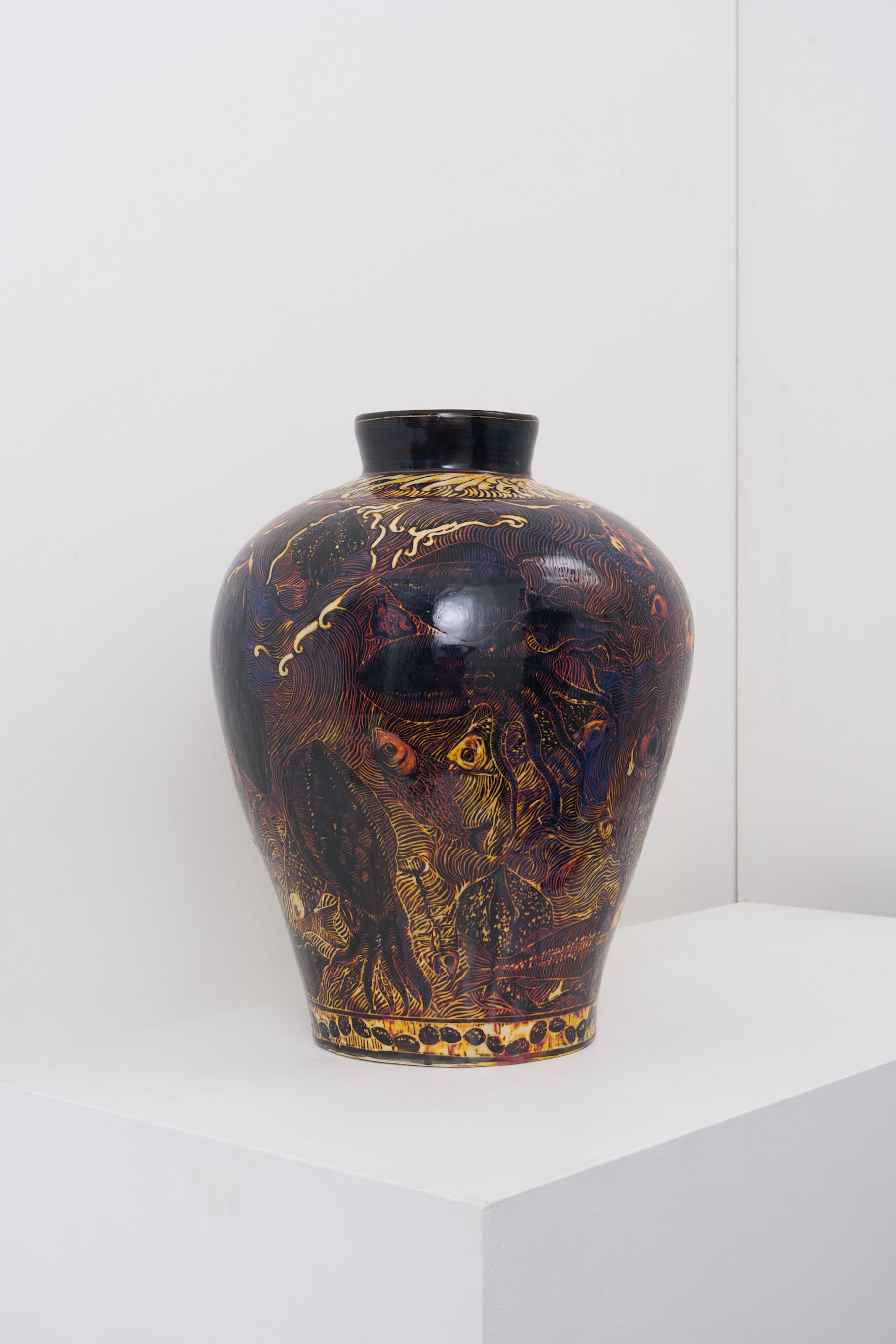Deep blues: When the artists are also champion surfers, the ocean is everywhere
This Little Machine showcases a masterful collection of new ceramics by Gerry Wedd, and a suite of work by Christian Lock, in a double header that highlights this tiny independent gallery’s big impact.

Two prominent South Australian artists – the abstract painter Christian Lock and ceramicist Gerry Wedd – are currently exhibiting some seriously good art at The Little Machine. Over the past couple of years this small, almost incognito gallery in the Regent Arcade has built a following amongst contemporary artists and art lovers. The gallery was established in 2023 by partners Dr Michael Newell and Dr Eleen Deprez as an independent space for contemporary art. The couple, who met at the University of Kent in the UK while Newall was lecturing there in aesthetics and art history, and Deprez was completing her PhD, are extremely well-credentialled, with lengthy CVs in both academia and contemporary art practice.
In June this year they moved from their original, very small location – a former shopfront leased through Renew Adelaide – to a slightly larger space in the same arcade with a grant from the City of Adelaide. To avoid over-reliance on external funding and support, Newall and Deprez are hoping that sales will contribute to offsetting their expenses in running the gallery. This approach has the double advantage that it benefits both the artist and the gallery – and is a welcome shift from the holier than thou antipathy to sales in many funded contemporary art spaces. Making the most of the limits of these intimate no-frills spaces, they have pursued a carefully curated and surprisingly ambitious program of exhibitions, events and talks, usually with a leaning towards experimental approaches, both by young artists fresh out of art school and by established artists like Lock and Wedd who are testing new directions in their work.

Superficially these two artists are a complete contrast. For his exhibition, ARC, Christian Lock has painted four large abstracts in which he has experimented with finishes, textures and colours achieved by using synthetic spray paints and industrial materials from non-art fields. In BLOOM, Gerry Wedd’s ceramics with their hand-painted cobalt-blue underglaze decoration, reference the long tradition of blue and white trade ceramics, while radically reinterpreting this genre through his intricate images of the fatal impact of the toxic bloom on South Australia’s marine life.
Apparently, these exhibitions were scheduled before Newall and Deprez became aware of the odd coincidence that both artists are champion surfers, a generation apart, who knew each other for many years as competitive surfers before they knew each other as artists. Yet this surfing background is present in the work. The centrality of deep blue in Lock’s paintings is surely influenced at least in part by his time as a surfer, immersed in the blue expanse of ocean and sky. In turn, Wedd’s new imagery is a direct response to his experience of dead sea creatures on the beaches of the Fleurieu Peninsula near his home at Port Elliott.
Lock’s large abstract paintings have a compelling muscular presence, dominating the intimate space with their scale, intense colour and sheer materiality. Textured spray-painted expanses of synthetic ultramarine pigment, applied in multiple layers over a black ground, create the optical experience of shifting densities from a transcendent celestial or marine blue to the inky black depths of oblivion. Lock refers to the intense spray-paint ultramarine as ‘phosphene blue’, the electric blue colour we see when we press down on our eyelids. This blue field is disrupted by geometric demarcations, grids and by strong bursts of colour from various mixed media laid over the surface of the canvas, creating an interplay between looseness and control.
The finished paintings retain an embedded or immanent sense of the raw energy and decision-making expended in their creation, as the end-product of an extended process of experimentation, of addition and subtraction, until a provisional point of resolution is achieved. This immanence – the notion of meaning inherent in materiality – is especially evident in the tortured, layered and torn surfaces of his largest painting, Again, made and re-made between 2017 and 2025. In his catalogue essay Newall describes this painting as ‘a beautiful ruin’, and it does indeed embody the Japanese notion of ‘wabi-sabi’, the beauty of imperfection, weathering and transience. It is a painting which invites close looking, and which does not exhaust its impact in a single viewing. Lock’s uncompromising abstracts are not pretty pictures, conceived as domestic décor. Rather, they would seem to belong in large scale brutalist concrete spaces, in an uncluttered modernist minimalist interior, or an adapted post-industrial warehouse, where the paintings have room to breathe so that their material/immaterial duality might be experienced.

Gerry Wedd’s ceramics may be domestic in scale, but they are gently (and occasionally not so gently) subversive in intent. His series of Bloom cups bear delicately painted depictions of dying or dead marine creatures and skeletons. Even in such simple objects, through his skill in underglaze painting he instils a sense of pathos and loss. The more ambitious new work in this exhibition comprises two magnificent mid-fired ceramic jars and six shallow porcelain dishes. In this body of work Wedd references the enduring themes of the still-life genre, known in French as ‘Nature Morte’ (Dead Nature), namely the transient beauty of life and ever-present mortality. These pieces reveal Wedd’s mastery of cobalt blue underglaze painting to achieve both linear fluidity and the translucent tonal nuances of watercolour. In one of the dishes, Deadpool, a mermaid or selkie floats lifeless amidst a crowded composition of marine creatures, reminiscent of the piles of dead sea life washed up along the coastline in recent months. In another, Bloom, the composition includes a grimacing skull, referencing the ‘Vanitas’ still-life tradition in which a skull or other symbolic reminder of death is part of the composition.
Subscribe for updates
The masterworks in a show in which there is no weak link must be Wedd’s two large jars, Big Bloom, with its complex blue and white underglaze painting, and the ominous Red Tide. In this latter piece, dense sgraffito markings are scratched through poured layers of creamy yellow, black and a deep blood-red slip to create shifting transitions of colour. Through this layering, scratching and painting Wedd has achieved a dense, complex composition of marine creatures swirling in the ocean current around the rotund form. Red Tide is an important work of art, a mourning vessel for the environmental tragedy that has left its mark on many South Australians.
Newall and Deprez’s achievement in mounting two such significant exhibitions in their modest and largely unfunded gallery must be acclaimed as a small miracle. This is a gallery powered by the passion of its directors and by the enthusiastic support of a cohort of Adelaide’s contemporary artists. While The Little Machine’s program is often more experimental in nature than this current exhibition would suggest, it is always worth venturing in to see what is on. In its short life it has become one of Adelaide’s most consistently interesting places to find adventurous, uncompromising and sometimes wonderful new art.
Gerry Wedd: BLOOM and Christian Lock: ARC continue at The Little Machine until November 1

